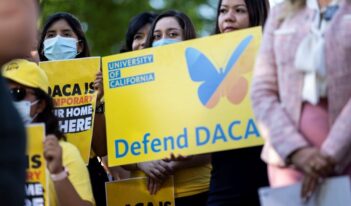
DHS has discretion to end its policy requiring noncitizens to wait in Mexico pending their immigration proceedings.
On the last day of its recently concluded term, the U.S. Supreme Court ruled on a long-awaited decision about the Biden Administration’s authority to terminate the “Remain in Mexico” policy—formally called the Migrant Protection Protocols, or just MPP.
In a 5-4 decision issued by Chief Justice John Roberts, the Court held that the Biden Administration did not violate Section 1225 of the Immigration and Nationality Act (INA) and that a guidance document issued in October 2021 by the Department of Homeland Security (DHS) to terminate the Remain in Mexico policy was a final agency action.
Remain in Mexico was designed during the Trump Administration and implemented in January 2019. The policy required certain noncitizens to wait in Mexico until their hearing date before a U.S. immigration court.
At the time, DHS pointed to Section 1225(b)(2)(C) as the authorizing statute for MPP. That statute reads: “In the case of an alien … who is arriving on land … from a foreign territory contiguous to the United States, the Attorney General may return the alien to that territory pending a proceeding under Section 1229a of this title.”
Consistent with President Joseph R. Biden’s commitment to end Remain in Mexico when he took office, DHS tried in 2021 to terminate the policy. The agency’s effort was complicated, however, by a lawsuit brought by Texas and Missouri challenging MPP’s termination. Relying on a neighboring provision of the INA—Section 1225(b)(2)(A)—the lower courts concluded that terminating Remain in Mexico violated the INA, arguing that noncitizens arriving under Section 1225 must be either detained or returned to Mexico. Section 1225(b)(2)(A) states that if “an alien seeking admission is not clearly and beyond a doubt entitled to be admitted, the alien shall be detained for a proceeding.”
Litigation ensued and, during this time, DHS Secretary Alejandro N. Mayorkas issued two different memoranda—oneon June 1, 2021, and the other on October 29, 2021. The second memorandum was accompanied by a 39-pageexplanation of the Department’s decision to terminate Remain in Mexico, concluding as follows:
Continuation of MPP—even in a significantly modified format—is inconsistent with the current policy approach of this Administration. Rather than forcing individuals to return to Mexico to await court hearings, this Administration is pursuing a range of other policies and rulemaking efforts—including regional approaches to addressing the root causes of migration and a reform of the asylum system—to better achieve the key goals of securing the border, reducing migratory flows, timely and fairly adjudicating asylum claims, and reducing the asylum backlog.
DHS noted that it would implement the termination of Remain in Mexico as soon as practicable depending on the outcome of the litigation.
On appeal, the Supreme Court first addressed the jurisdictional question by examining the scope of Section 1252(f)(1), a provision that states “no court (other than the Supreme Court) shall have jurisdiction or authority to enjoin or restrain the operation” of certain immigration actions. The Court held that, although Section 1252(f)(1) prevented the district court from entering an injunction to stop the Biden Administration from terminating the MPP, it did not deprive the lower court of “all subject matter jurisdiction.” The Court also found the text of Section 1252(f)(1) left no question that the Supreme Court does have jurisdiction to hear the case.
The Court then moved to the merits, where it dismissed the respondents’ and the lower courts’ arguments that returning noncitizens to Mexico is mandatory. The Court looked at the plain language of Section 1225(b)(2)(C) and reported that “the statute says ‘may.’” The Court concluded that “‘may’ does not suggest discretion, it ‘clearly connotes’ it.”
The Court refused to shoehorn any concern about Section 1225(b)(2)(A) into what is authorized under Section 1225(b)(2)(C), stating that “the desire to redress the government’s purported violation of Section 1225(b)(2)(A) does not justify transforming the nature of the authority conferred by Section 1225(b)(2)(C).”
The Court also pointed to the history of Section 1225(b)(2)(C) to demonstrate the discretionary use of that provision since it was enacted in 1996. Furthermore, the Court pointed to the meaningful foreign affairs consequences of transforming Section 1225(b)(2)(C) into a mandatory requirement, namely the burden such a reading would impose on the executive branch during the course of U.S.–Mexico relations. Finally, the Court drew attention to the availability of parole—a statutory mechanism by which an arriving noncitizen can lawfully enter the United States—as yet another indicator that implementing MPP is not mandatory.
In sum, the Court found that Section 1252(b)(2)(C) “means what it says: ‘may’ means ‘may,’ and the INA itself does not require the Secretary to continue exercising his discretionary authority under these circumstances.”
The Court also dismissed the arguments by the court of appeals that the second Mayorkas memo terminating MPP did not constitute new agency action. Distinguishing the Remain in Mexico case from DHS v. Regents of the University of California—a case about a DHS memo rescinding another well-known but separate policy known as DACA—the Court found here that the DHS secretary had issued his second Remain in Mexico memo with several new explanations for ending MPP. The Court found both Remain in Mexico memos to be separate actions, both of which were final agency actions.
The Court reversed the decision of the court of appeals and remanded the case for further proceedings. The Court also asked the district court to consider if the second Mayorkas memo complied with the Administrative Procedure Act. This procedural opening means that the long-term future of MPP is somewhat unknown. But in the near term, MPP is terminated and the short-term future of the policy is gone.
Although the ruling in Biden v. Texas is a sound victory for immigration and refugee advocates and the thousands of asylum seekers subject to MPP, the human consequences have been profound. Over 70,000 people had been processedunder MPP and in most cases without representation from counsel.
Critics of MPP have also been concerned about the conditions that asylum seekers faced in Mexico. According to Human Rights First, there have been “at least 1,544 publicly reported cases of murder, rape, torture, kidnapping, and other violent assaults against asylum seekers and migrants forced to return to Mexico.”
Ensuring that those who remain in Mexico are returned to the United States will be crucial, as will be an investment into identifying those impacted by MPP and compensating them for the barriers they faced as a direct result of the program.
Finally, the Supreme Court’s decision should signal a broader reflection by the Biden Administration on its border policies and how it can use its discretion to roll back provisions that undermine its own principles, the rule of law, and our shared humanity.
This essay is a part of a ten-part series entitled The Supreme Court’s 2021-2022 Regulatory Term.




